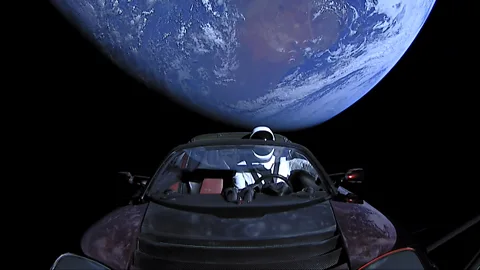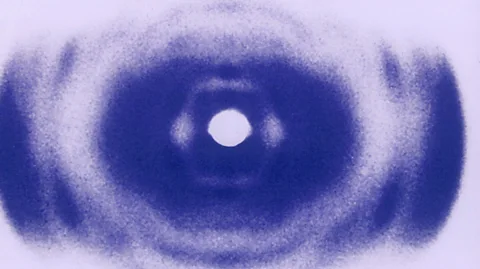How to store data for 1,000 years
 Alamy
AlamyMost current data storage systems eventually stop working. But there are alternatives on the horizon.
"You know you're a nerd when you store DNA in your fridge."
At her home in Paris, Dina Zielinski, a senior scientist in human genomics at the French National Institute of Health and Medical Research, holds up a tiny vial to her laptop camera for me to see on our video call. It's hard to make out, but she tells me that I should be able to see a mostly clear, light film on the bottom of the vial – this is the DNA.
But this DNA is special. It does not store the code from a human genome, nor does it come from any animal or virus. Instead, it stores a digital representation of a museum. "That will last easily tens of years, maybe hundreds," says Zielinski.
Research into how we could store digital data inside strands of DNA has exploded over the past decade, in the wake of efforts to sequence the human genome, synthesise DNA and develop gene therapies. Scientists have already encoded films, books and computer operating systems into DNA. Netflix has even used it to store an episode of its 2020 thriller series Biohackers.
The information stored in DNA defines what it is to be human (or any other species for that matter). But many experts argue it offers an incredibly compact, durable and long-lasting form of storage that could replace the many forms of unreliable digital media available, which regularly become defunct and require huge amounts of energy to store. Meanwhile, some researchers are exploring other ways we could store data effectively forever, such as etching information onto incredibly durable glass beads, a modern take on cave drawings.
But how long could this data really last, and can we really rely on it to store the reams of data now being produced by humanity for posterity?
***
As we move towards a more and more digitised world, our reliance on data is skyrocketing. Films, photographs, webpages, business documents, critical security records – everything we use is digitalised, and we are using increasingly more of it.
Most of the reams of data we have produced is stored as 1s and 0s on magnetic tapes such as hard drives, but this is far from an ideal solution. For one thing, demagnetisation is a huge issue – permanent magnets gradually lose their magnetic field over time, so to keep data reliably it's important to rewrite hard drives every few years. "It lasts on average maybe 10 to 20 years, maybe 50 if you're lucky and the conditions are perfect," says Zielinski.
 Getty Images
Getty ImagesStoring data also requires huge data centres which use large amounts of energy to keep things cool – not ideal in a world prone to energy crises. The problem is seen as significant – the US government's molecular information storage (Mist) programme, launched in 2019, aims to find an alternative to today's huge data storage facilities, for example.
"We're actually running out of hardware. I think that industry can't really keep up with generating enough hard disks and servers to store all this data on," says Zielinski.
But do we really need to keep all this data, and preserve it for so long?
People want to store data for the long term for a huge variety of reasons. One is science – researchers are generating unprecedented amounts of data, and the more they have, the better. Radio telescopes and particle accelerators like the Large Hadron Collider (LHC) at the European Organization for Nuclear Research (known as Cern) on the border of and Switzerland, for example, generate reams of data, and scientists want to keep all of it, says Latchesar Ionkov, a computer scientist working on DNA storage at Los Alamos National Laboratory. The LHC alone produces 90 petabytes (90 million gigabytes) per year.
Mark Bathe, a professor of biological engineering at Massachusetts Institute of Technology, co-founded the start-up Cache DNA to make biomolecules widely accessible and useful. The global threats facing humanity compel us to preserve both human-made information, such as art and science, and the DNA of all living things on the planet, says Bathe. "That way, if life were to either be recreated here or otherwise transferred or imported from other planets and so forth, there would be records of what we did, and what we had," he says.
Many DNA storage researchers believe they have hit on the perfect storage medium for both widespread and incredibly long-term storage. We typically view DNA as a way to store genomic information, but many researchers are now excited about the possibility of storing the vast quantities of digital data currently choking up data centres across the world.
DNA is a natural choice here, says Bathe. "Nature has used DNA for many millennia to store information in the form of genomes," he says. "It's been around [for billions of years], it's something that you can kind of bank on. As long as that's the fundamental information storage medium of a species, like humans, then it's going to be something that we know what to do with."
 Getty Images
Getty ImagesCompare the fact that DNA has been optimised over the last 3.7 billion years or so to the information age, which really began in the 1950s, says Zielinski. "We've come pretty far in man-made technology, but it doesn't get much better than DNA in of efficiency – when we start as one cell, all the instructions are there to direct every single cell until you reach the nearly 30 trillion cells that make up a human."
What's more, the fact we can recover DNA fragments from million-year-old animals such as woolly mammoths that deliver meaningful data about their genomes shows DNA is incredibly durable, says Zielinski. The half-life of DNA – the time it takes to degrade by half – is around 500 years in a well-preserved fossil, which means the DNA would cease to be at all readable after around 1.5 million years.
However, DNA is incredibly fragile, and the conditions that lead to fossilisation are extraordinarily rare. "There are tonnes of ways to destroy it," says Olgica Milenkovic, a professor of electrical and computer engineering at the University of Illinois at Urbana–Champaign. Humidity, acids, and radiation all damage DNA. "But if it's kept cold and dry, it's good for hundreds of years."
You might also like:
Even better, DNA can be protected by encapsulating it inside other materials such as glass beads – mimicking how genetic material is protected within ancient fossils. Robert Grass, a researcher at ETH Zurich, Switzerland, and his team have shown these beads protect the DNA from both chemicals and heat.
Further protection could come from locating it in a physically safe place. Storing data critical for humanity in encapsulated DNA in an ice vault could mean "it can last forever, pretty much", says Milenkovic.
Another huge perk of DNA is that it is incredibly dense store of information, to an extent unmatched by any other man-made device. The estimated 33 zettabytes of data that humans will have produced by 2025 (that's 3.3 followed by 22 zeroes) could be squeezed into the size of a ping-pong ball with DNA storage, according to Ionkov. He believes storing this much information in DNA could be mere decades away.
 Alamy
AlamyDNA storage is also unlikely to ever become obsolete, unlike other man-made storage media – "which one of us still uses floppy disk">window._taboola = window._taboola || []; _taboola.push({ mode: 'alternating-thumbnails-a', container: 'taboola-below-article', placement: 'Below Article', target_type: 'mix' });
